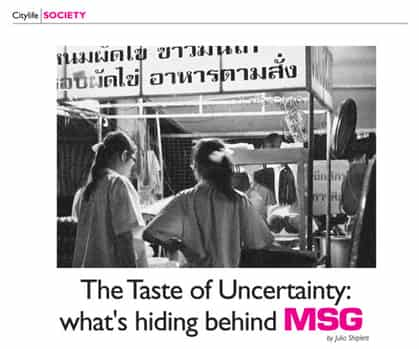
Monosodium glutamate, better known as MSG to westerners and phong churot to Thais, is an additive used to enhance the flavour of food it’s cooked or served with. With an appearance not far from ordinary table salt, it’s a form of naturally occurring glutamic acid extracted through a fermentation process that converts the substance into a concentrated, usable ingredient.
Pointing a finger at what MSG actually does to food is not so easy. In essence, it creates umami, the allusive fifth element of taste that is difficult to put in to words but recognised by our receptors as savoury. Phong churot has the power to bring out the deliciousness in a dish that Thais typically greet with open arms and a salivating mouth.
As Aaron Espana, a Chiang Mai-based food writer, puts it, “It rounds out a flavour; it puts in an umph.” And umph is what they want. “When they eat food, when they eat a yam, a salad, what is it? It’s hot, it’s sour, it’s spicy, it’s sweet, it’s garlic-y, it’s everything… They’re pushing everything to 10 or 11.”
There are different types of flavours; MSG is just one type. Spice is spicy, but when you mix it [with MSG], it tastes much better,” said Pang Fah Lai Sai who runs a small food shop off Suthep Road.
Since its discovery as a marketable ingredient in Japan over a century ago, MSG has swept through kitchens throughout Asia, and Thailand is no exception. It’s commonly thrown into a heating wok, added to a pot of boiling soup or curry or simply sprinkled on top of a meal as a garnish. Although it’s difficult to say how widespread its use actually is, the possibility of ingesting some every day outside of home is quite high.
The oldest and most unmistakable brand is Ajinomoto, its label in bold red print can be seen anywhere from the local market to shelves at 7-11. However, the ingredient is found under other names like Knorr, OXO and Rot Dee (meaning good taste). In some ways, it’s the perfect ingredient – popular, widely available and dirt cheap.
There is of course the long-standing concern that MSG carries harmful health risks linked to headaches and dry throat all the way to neurological damage and diabetes. Despite years of research and studies on the effects of processed glutamate on our bodies, data is by and large inconclusive and anecdotal.
The truth is that glutamic acid forms naturally in foods like soy sauce, seaweed and tomato, but in very small doses. However, when you casually use it from the bag, its quantity may be impossible to determine.
“When you eat it in a food, it’s naturally occurring in micrograms. And when you’re eating it in food, [with it put in], they’re using a tip of a spoon,” Espana said, “so you’re eating 20, 30, 40 times what would be natural.”

Whether it really does affect us or if its paranoia, people appear to have different levels of tolerance. Most Thais seem willing to accept flavour over a little discomfort, but Rachabordin Boonchaiyo is not most Thais.
Manager and chef of Pun Pun – a restaurant serving natural vegetarian and mostly organic dishes – Boonchaiyo says he knows when it’s gotten into his system. His nose starts to itch and he feels like a balloon is in his throat, which was enough to make him give it up cold turkey years ago.
In a country filled with spices, herbs and natural ingredients other places will pay big bucks to import, it begs the question: Do we really need the stuff? The answer appears to be a tentative ‘yes.’
Like others addictions, many Thais have grown up with it in their diets all their lives, making it a tough habit to break.
“For me, without MSG, I can’t even taste [flavour]. The taste is not as good,” said Lai Sai.
In addition to taste, the main reason MSG is so pervasive is it saves two valuable aspects of any business: time and money.
As Npat Wisawakul, a nutrition teacher at Chiang Mai University explained, making good, healthy food is a lot more work at a much higher cost when having to buy separate components and make everything from scratch.
“To make a soup, if [you] use many ingredients, it makes it more expensive,” she said.
Boonchaiyo goes out of his way to make his food as natural, fresh and organic as possible, but he too admits cooking this way is challenging. “When you don’t use MSG, it means you have to cook [everything] yourself. Sauce or the chilly paste, I have to make it by myself.”
If there is one identifiable problem emerging, it’s the ingredient’s ability to mask less effort and low quality with big taste by replacing a healthy, balanced diet with temporary satisfaction. It may be the mentality of laziness and unconscious penny-pinching that are the true culprits rather than the ingredient itself.
“[People] have to work hard for their children, but sometimes they have no time for themselves. That’s a problem,” said Boonchaiyo. “You have to make a balance. Food is the same thing.”
Many westerners in Asia are alarmed by the ubiquity of MSG and try to stay clear of it, but what they may not know is that MSG is already under their noses in popular fast food chains and processed foods like Kraft products back home. It’s just better hidden.
Unlike others foreigners, Espana doesn’t buy into the hype. “If it’s bad for you, how many Thais are getting headaches?”
“It’s funny – some of the same people who will take vitamin supplements, take all these artificial scientific forms of chemical vitamins trying to be healthy. And here they are worried about this powdered supplement of taste that is derived from food or natural things,” he said.
Certain dishes usually already have MSG added before you can say anything, but the good news is many cooks and restaurant owners respect the request of ‘mai sai phong churot’ – no MSG please.
According to Wisawakul, it’s in the best interest of the business to abide by customers’ wishes. “If the customer is allergic, it’s bad for the restaurant.”
As a cook himself, Lai Sai agrees: “It depends on how people want it. If they don’t want [MSG], we won’t put it in. But normally 80 percent of people don’t say ‘without MSG.’ Almost all people like it.”
Other times, it’s simple miscommunication. When describing the familiar scenario of a foreigner with a specific food request, Espana explained, “Something will happen – either get lost in translation right at the table or between the table and talking to the cook. So you got to have that relationship and talk to the cook… You got to get to the person who’s actually going to make the decision.”
As far as the government’s role in encouraging healthy eating and responsible food preparation, the Public Health Office has improved standards of cleanliness and safety through the Clean Food, Good Taste project over the years. The campaign rewards sanitary establishments with certificates that ensure customers the place is clean. But as of now, monosodium glutamate is not on top of the priority list.
A change is unlikely to happen quickly, but Boonchaiyo says it starts with the customer.
“The customers help a lot. We have to reject, we have to go against. If you question the businessman or restaurant about that, they have to change it,” he said.
At the end of the day, the long-time vegetarian still takes it upon himself to serve his customers the best he knows how: “If I have to be a cook, it means I have to be responsible for people who eat my food. It’s not about if it’s hard or not – we have to do it.”
